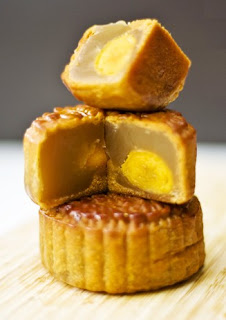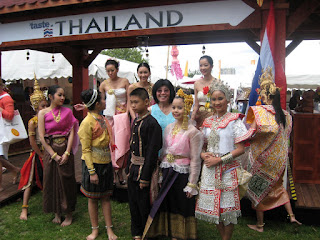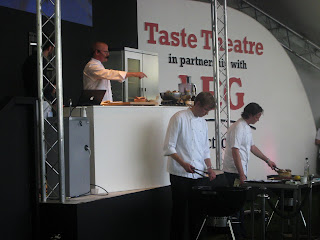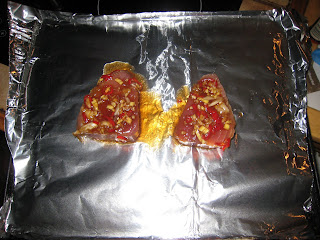Sunday, 17 October 2010
The Chocolate Unwrapped Show 2010
As soon as I arrived at the show venue, I was immediately greeted by a human-size chocolate wall where you could sign your name with a scraper-pen! This was a great way to kick-off the event and the smell of chocolate emanating from the wall really prepared you for the indulgence ahead. Moving through a wide corridor into the main rooms of the event, there were tables displaying information of the history of chocolate, samples of cacao beans and details of how chocolate is made.
When entering the main room, you were instantly overwhelmed by the vast range of chocolate stands lining the room. Each had their own individual and for most, extravagant displays to entice you to their stand. I obviously didn’t want to miss any out so chose the most luxurious-looking stand to begin my route around the entire room! Every chocolate brand had keen representatives who provided details and samples of their products and the following were particular highlights: -
Cacao Sampaka
First introduced in Spain, specifically Barcelona, this brand was distinguished by its eclectic creations such as Jamaican pepper, curry, fried corn and parmesan cheese chocolate. At the stand I was able to taste their best selling Gin & Tonic chocolate, which had a smooth texture to the chocolate with fizzy crystal-like pieces that were gin flavoured. Since the chocolate contained no alcohol, the essence of gin I could taste had been created from the aromatic, bittersweet and piny taste of juniper berries. In addition to this, I tried their blackberry flavoured dark chocolate and dark chocolate covered freeze-dried raspberries, which were extremely fruity and definite favourites of mine.
Patchi
This stand was probably the best presented brand and has come along way from their original opening in Beirut in 1974. Their unique methods of chocolate making and designing have made them somewhat of a trendsetter and today Patchi is a global brand. It is not surprising that I was impressed with their stand display, as one particular service they offer is chocolate arrangements that are creative and gracefully set to reflect occasions. There was such a large range of chocolate to try, but I was most drawn to their selection of chocolate covered nuts and the almond and pistachios were especially delicious.
The Rabot Estate
As Saint Lucia’s (West Indies) oldest cocoa estate established back in 1745 and home to the sought after Trinitario bean, The Rabot Estate was bought by the original founders of Hotel Chocolat 5 years ago. This enterprise enabled the taste of Saint Lucian chocolate to be tasted for the first time ever and the use of recipes that do not contain vanilla, allowed the true flavour to shine through unimpeded. The brand now has a chocolate café and chocolate shop in Borough Market and their stand at the Chocolate Unwrapped Show stood out from others as they offered samples of Cocoa Tea. Unlike other cocoa based hot drinks, Cocoa Tea is not sweet or as strong as our well known hot chocolate, however still has the distinctive cocoa flavour.
Artisan du Chocolat
Having already experienced their sea salted caramel range of chocolates with extraordinary flavours of peppers, balsamic vinegar, lemongrass and sage & thyme, amongst many others, I was already aware of the inventiveness of this brand. At the event, however, I was drawn to their stand by the beauty of their South Sea and Tahiti Pearls. Obviously inspired by the natural wonders of luxurious pearls, these chocolates looked almost too good to eat! The use of edible pearlescent pigments gave the truffles real sparkle and they would be ideal gifts for the ladies.
Chocri
Founded in 2008, this newborn chocolate company was the only stand to have a chocolate fountain. As a taster of what their company has to offer, I was given a shot of melted chocolate and a choice of ingredients including pretzels, nuts, gummy bears, strawberry bits and coconut that I could add to the shot as I wished. Their company’s aim is to create ‘great tasting premium chocolate customised to the wishes of their customers’ and they have a range of over 100 toppings to choose from. This is the first ‘create your own chocolate bar’ company I have come across and seems perfect for personalised presents.
In addition to the chocolate stands, the final room of the event was an exhibition of chocolate sculptures and this was also where talks from top chocolatiers, experts and authors were held. The sculptures were amazing and I will let the photos speak for themselves…
In addition to tasting a huge range of chocolates, I was able to attend plenty of the talks available at the show. These included:
- A presentation from Keith Hurdman, Master Chocolatier of Thorntons.
- A cooking demonstration with Micah Carr-Hill, Head of Taste at Green & Black’s
- A chocolate tasting session conducted by Paul A Young
- Chocolate personality readings from Murray Langham; and
- A talk from Niki Segnit on her book- The Flavour Thesaurus.
Wednesday, 6 October 2010
Discover: The Moon Cake
In the present day, Chinese people will generally celebrate the Moon Cake Festival with entertainment, feasting and moon-gazing, but the most important and central element of the festival is the moon cake. Moon cakes are around the size of a palm and can be either round or square in shape. Inside traditional moon cakes is lotus seed paste with one or more yolks from salted duck eggs placed within the paste. These represent the full moon or phases of the moon and the filling is encased in a golden brown crust that is usually decorated with symbols of the festival, either by hand or more commonly by moulds.
The moon cake is a delicacy that is so far from normality in the UK that it highlights just how different the Chinese and British cultures are. I believe that everyone should be adventurous with what they choose to eat and if you have the opportunity to try something new, you should go for it and experiment! You may even gain some insight into the history of another culture in addition to a new favourite food.
Those who have tasted a moon cake may describe it as an acquired taste; however, I think they are extraordinary. Since the filling is a paste and the crust is only thin, moon cakes are quite dense and very rich in flavour. The saltiness from the egg yolk contrasts with the sweet lotus paste, which gives an enjoyable balance of flavours. Typically, the moon cake is cut into segments and shared around, since a few pieces can be rather filling.
Along with lotus seed paste; red bean and black bean pastes are also common fillings and over the years, a vast range of moon cakes have been created with differing fillings and crusts. It is not uncommon to now find dates, nuts, fruit, Chinese sausage, pumpkin, yam or seeds in moon cakes. They are fairly difficult to make, so most choose to buy them when they become available in Chinese bakeries or supermarkets around mid-August.

Although moon cakes are innately unique and essential to the Moon Cake Festival, their existence has played a more legendary role in Chinese history. The story slightly resembles the Trojan War (a Chinese one!) with moon cakes embodying the ‘Trojan Horse’ which brought about a revolution. During the Yuan Dynasty (from 1280-1368 A.D.), China was under the oppressive rule of the Mongols for almost a century. In this time, the common Chinese suffered extensively and any attempt of a rebellion was cruelly punished. An intricate plan was therefore formulated to overthrow the Mongols and the Chinese baked hundreds of moon cakes during the Mid-Autumn Festival in preparation. However, instead of the fillings we would expect to find today, messages inciting people to join an impending rebellion were hidden inside and they were distributed among family and friends. As the Mongolian people did not eat moon cakes and paid no attention to them, they were completely taken aback by the well designed rebellion and it lead to the abrupt demise of the Yuan Dynasty.
 |
| A giant Moon Cake created for the Mid-Autumn Festival |
Wednesday, 15 September 2010
The Essential Taste Festival Guide
Taste festivals happen in 12 cities Worldwide- Amsterdam, Auckland, Birmingham, Cape Town, Dubai, Dublin, Edinburgh, Johannesburg, London, Melbourne, Milan and Sydney with the unique Taste of Christmas also taking place in London. Each of the city’s top restaurants and chefs gather in a venue and visitors use the festival currency of Crowns to purchase taster portions of their signature dishes.
The size of the festival depends on the host city and Taste of London in particular is the capital’s largest food and drink event. I attended Taste of Christmas in 2008 and by comparison, Taste of London is much larger with an abundance of things to do and see.
Each year there is a specific theme within the Taste of London; in 2009 there was Taste of Thailand and this year was Taste of Malaysia. To celebrate the chosen country and its cuisine, there is a specific area in the event where you can experience various elements of their culture. For instance, the 2009 Taste of Thailand section of the festival integrated London’s most popular Thai restaurants with live demonstrations from Thai master chefs, a bar serving specially created Thai cocktails, cultural Thai dance shows and even The Tourism Thailand team for any travel advice in visiting Thailand!
Typically, each day the Taste of London festival runs is split into two sessions; lunch (12.00 -16.00) and dinner (17.30-21.30). Having visited Taste of London at Regent’s Park in 2009 and this year, I realised that although four hours sounds a lot, if you want to make the most out of the festival (and leave blissfully glutted!) you should plan your time. So here is my personal guide to organising your visit:
On arrival, you will receive the Taste Menu Card, essentially a small brochure that provides timetables (for all live demonstrations, master classes and musical entertainment), the list of restaurants with menus and a map of the event.
1. Select the Sessions you wish to Attend
Firstly, since each timetable conflicts with each other, you will have to be very selective about what sessions you want to go and see. I recommend focusing on the Taste Theatre where the Michelin starred chefs give live demonstrations. However, if you are more interested in tasting food, choose no more than 2 sessions from all the timetables as they can last up to 40 minutes each (which cuts into your eating time!).
Once you have decided on the sessions you will attend, mark the times on your map and remember to arrive early to ensure a seat.
2. Choose the Dishes you want to Taste
A table of all the dishes that are being provided by the restaurants (with their prices in Crowns) can also be found in the Taste Menu Card. Since it is impossible to taste every dish on offer, you will again have to be selective! I usually select mainly appetizers and main dishes with a few desserts to help with the sweet-savoury battle.
In previous years, most dishes have cost between 6 and 12 Crowns , bar a few icon dishes that can cost up to 40 Crowns (where 1 Crown = 50p). I find that to maximise the range of dishes you taste, the best tactic is to pool your Crowns with a few friends (ideally so there is 3 of you) and share each dish that you purchase. Even though you will have less of each dish, the range of dishes you try will be greater- and you can always repeat the dishes you loved!
3. Use the Event Map to Create a Route
I don’t mean this in a ‘sat nav’ way, but it is quite handy to mark on your map where you will get the dishes you selected. This way, you can pick up dishes en route to the sessions you attend and having food is a saviour when the live demonstrations make your mouth water!
Hopefully, with this guide in mind you can make the most out of any Taste Festival.
The next Taste of London event is set for 16th to 19th June 2011. However, if you can't wait, Taste of Christmas is running from 3rd to 5th December 2010 and is a great taster of what to expect from a Taste Festival.
Tuesday, 10 August 2010
Hot Teriyaki Tuna Steaks
Ingredients:
2 Tuna Steaks
Spring Onions to garnish
For marinade:
3 tbsp Dark Soy Sauce
2 tbsp Sesame Oil
1 tbsp Rice Wine
1 tbsp Caster Sugar
3 Cloves of Garlic
1 Red Bird's-eye Chilli
A small piece of Ginger Root
1. Prepare the ingredients by thinly chopping the spring onions, crushing the cloves of garlic, finely chopping the ginger root and slicing the chilli.
2. Combine the soy sauce, sesame oil, rice wine and caster sugar in a bowl large enough to fit the tuna steaks and add the garlic, ginger and chilli. Mix together to ensure the garlic, ginger and chilli infuse in the liquid part of the marinade.
3. Place the tuna steaks in the marinade and use a spoon or even better your hands to ensure every surface is covered in the marinade. Cover and leave for 30 minutes.

4.Grill the tuna steaks on a baking tray for 3-4 minutes each side, basting with the remaining marinade. Sprinkle with spring onions and serve immediately.
Ideal accompaniments for this recipe are cous cous, basmati rice, risotto, green beans, asparagus, roasted vegetables or even a simple green salad.
Wednesday, 4 August 2010
Top 10 Dim Sum Orders
A custom that originated in Chinese Teahouses was Dim Sum, established in recent times as “small snack” or “little eats” (although, the literal translation is “to touch your heart”). It is essentially the Chinese version of tapas with a wide variety of steamed, fried or baked dishes; predominantly savoury with a few sweet. Dim Sum is typically eaten as brunch, being served from breakfast time into late afternoon; however increasing popularity has meant that some restaurants will serve all-day dim sum, which is good for us!
Our beloved China Town on Gerrard Street is an ideal place to go for Dim Sum, with most restaurants having ‘All You Can Eat’ offers (again- good for us, but don’t snack before you go!) I recently went to a place I would recommend, the Golden Harvest to indulge in some Dim Sum and I started thinking about my top dishes. So here we go… my Top 10 Dim Sum Orders:
1. Shanghai Steamed Soup Dumplings (Xiao Long Bao) – possibly the greatest Dim Sum dish. They are known as ‘small basket dumplings’ that contain mince pork (or variations such as prawn or crab meat mixed with mince pork) wrapped in a dough skin. However, the best part of this dish is the superior soup inside the dough case, which is indescribably good. A way to eat these dumplings is to firstly bite a small hole in the base and pour out the soup into a spoon to drink, and then eat the rest. Delicious!
 2.Taro dumplings/ Stuffed Yam Croquettes (Wu Gok) – these are great to start off a Dim Sum sitting. They are made from yams that form a croquette with a filling of pork, dried shrimp and Chinese dried mushrooms.
2.Taro dumplings/ Stuffed Yam Croquettes (Wu Gok) – these are great to start off a Dim Sum sitting. They are made from yams that form a croquette with a filling of pork, dried shrimp and Chinese dried mushrooms.
 3. Turnip Cake (Lo Bak Go) – made from Mooli (a Chinese turnip) and rice flour with dried shrimp and Chinese pork sausage bits. This dish is steamed, cut into slices and pan fried for added texture.
3. Turnip Cake (Lo Bak Go) – made from Mooli (a Chinese turnip) and rice flour with dried shrimp and Chinese pork sausage bits. This dish is steamed, cut into slices and pan fried for added texture.
4. Steamed Barbecue Pork Buns (Char Siu Bao) – this is probably the most popular dish. They are fluffy white buns that contain a Cantonese barbecued pork filling. The bun and barbecue sauce are both slightly sweet, which contrast perfectly with the savoury pork.
 5. Prawn and Mango Roll – not a traditional dim sum dish, but nonetheless still scrumptious! Whole King prawns and thin slices of fresh mango are wrapped in a thin pastry similar to the shape of a spring roll, which is then coated in sesame seeds and fried.
5. Prawn and Mango Roll – not a traditional dim sum dish, but nonetheless still scrumptious! Whole King prawns and thin slices of fresh mango are wrapped in a thin pastry similar to the shape of a spring roll, which is then coated in sesame seeds and fried.
 6. Shrimp Dumplings (Har Gow) – this is another famous steamed Dim Sum dish, easily identified by their translucent and pleated wrapper. Inside, the filling contains a shrimp and bamboo shoot combination.
6. Shrimp Dumplings (Har Gow) – this is another famous steamed Dim Sum dish, easily identified by their translucent and pleated wrapper. Inside, the filling contains a shrimp and bamboo shoot combination.
 7. Glutinous Rice Wrapped in Lotus Leaf (Lo Mai Gai) – sticky rice filled with chicken, Chinese mushrooms, Chinese sausage, bamboo shoots, spring onions and sometimes dried shrimp. They are cooked in unique way, being wrapped into parcels using dried lotus leaves and steamed, but don’t eat the leaves!
7. Glutinous Rice Wrapped in Lotus Leaf (Lo Mai Gai) – sticky rice filled with chicken, Chinese mushrooms, Chinese sausage, bamboo shoots, spring onions and sometimes dried shrimp. They are cooked in unique way, being wrapped into parcels using dried lotus leaves and steamed, but don’t eat the leaves!
 8. Pork and Shrimp Dumplings (Siu Mai) – this is a very distinctive steamed dish shaped like a basket with a shrimp and pork filling topped with a sprinkling of crab or fish roe.
8. Pork and Shrimp Dumplings (Siu Mai) – this is a very distinctive steamed dish shaped like a basket with a shrimp and pork filling topped with a sprinkling of crab or fish roe.
 9. Rice Noodle Rolls (Cheung fun) – sheets of rice noodle stuffed with which ever filling you fancy: prawn, beef, pork or even scallops.
9. Rice Noodle Rolls (Cheung fun) – sheets of rice noodle stuffed with which ever filling you fancy: prawn, beef, pork or even scallops.

Lastly, don’t forget your tea or “yum cha”! The most popular Chinese teas are Chrysanthemum, Green and Oolong.
Friday, 23 July 2010
…make lemonade?
I’m Annabel-Zoe, a complete food lover and am using this blog to finally share all my food experiences! A person close to me once described me as having an obese person inside; a slightly outlandish expression for my infatuation with food, but nevertheless it is true!... I love smelling, tasting, observing, cooking and mostly talking about food!
Reminiscing about my childhood, it is clear my passion for food started early. Since learning to use chopsticks from the age of one and a half, I was always very adventurous in trying any dish placed in front of me and was most eager to try the strangest looking one! Having parents from Hong Kong and Malaysia has meant I was always exposed to Chinese and Malay home cooking as well as British food, all fuelling my interest in cooking!
It is cliché, but food is the ‘fuel of life’ and with inspiration from other food blogs (The Bitten Word and A Slice of Cherry Pie) I will share my every encounter with food, from recipes to cooking experiences to restaurants and everything delicious!














